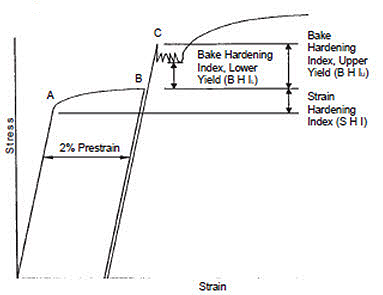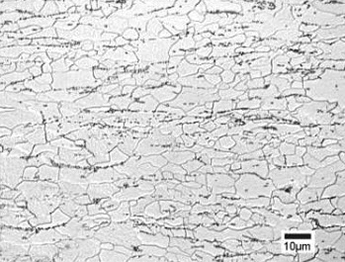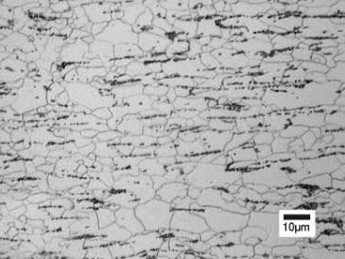Dent Resistant Steels
Abstract
The continuous focus on weight reduction in the automotive industry demands thinner materials with compromising key factors such as performance and safety.
Dent resistant steels can be classified into non bake-hardenable and bake-hardenable groups or Type A and Type B respectively as classified by SAE.
The increased importance on weight reduction is driving automotive industries to reduce thickness of the steel panels without compromising the vehicle safety and performance.
In the last few decades, steel makers continuously introduced new grades with high strength and good formability to meet the target of stiff and light automotive body. The poor formability of high strength steels is a major concern while considering its candidature for automotive panels. Materials for outer body panels like fenders, doors, hood and deck lid require good formability to make the design attractive.
As the above components are external parts, the chances of getting dented from stone impact and the careless opening of an adjacently parked vehicle door is high. Hence they require high static dent resistance (SDR) properties, which in turn demands high strength. SDR is a measure of resistance to permanent deformation caused by static forces.
Bake hardening steel (BH) provides good formability before stamping and has enhanced strength post baking. Hence BH steel is widely used in vehicles, thus leading to a reduction in vehicle weight and improved safety. Bake hardening steels derive their increase in strength from a strain ageing process that takes place on paint baking at 180°C.
There are two types of dent resistant steels, non bake-hardenable and bake-hardenable. SAE has classified them as Type A and Type B, both of which are available in grades with minimum yield strengths of 180 MPa. Dent resistant steels are cold reduced low carbon (0.01-0.08%), typically deoxidized and continuous cast steel made by basic oxygen, electric furnace, or other processes that produce a material that satisfies the requirements for the specific grade.
The chemical composition must be capable of achieving the desired mechanical and formability properties for the specified grade and type. For grades 180 and 210, using an interstitial free (IF) base metal having a carbon content less than 0.01%, an effective boron addition of <0.001% may be required to minimize secondary work embrittlement (SWE) and to control grain growth during welding.
Dent Resistant Type A steel is a non bake-hardenable dent resistant steel achieving the final strength in the part through a combination of initial yield strength and the work hardening imparted during forming. Solid solution strengthening elements such as phosphorus, manganese and/or silicon are added to increase strength. Work hardenability depends upon the amount of carbon remaining in solution, which is controlled through chemistry and thermo-mechanical processing. Small amounts of columbium, vanadium, or titanium are sometimes used, but are limited because they reduce ductility.
Dent Resistant Type B steel is a bake-hardenable dent resistant steel that makes up a relatively new class of sheet steel products. They offer a combination of formability in the incoming steel and high yield strength in the application that is not attained in conventional high strength steels.
They can potentially be substituted for drawing quality sheet at the stamping plant without requiring major die modifications. The combination of formability and strength makes bake hardenable steels good options for drawn or stretched applications where resistance to dents and palm printing is important in applications such as hoods, doors, fenders, and deck lids. Bake hardenable steels may also assist in vehicle mass weight reduction through downgaging.
The forming operation imparts some degree of strain hardening which increases yield strength in bake hardening Type B steels. The paint baking cycle, typically 175°C (350°F) for 20 to 30 minutes provides another increase in yield strength due to moderate “carbon strain aging”. Material properties are generally stable, depending on the process. Figure 1 illustrates the hardening process with bake hardening steels.

Figure 1: Schematic Illustration Showing Strain Hardening and Bake Hardening Index and the Increase in Yield Strength that Occurs During the Bake Cycle
Application
Dent resistant steels are widely used in the automotive industry. Exposed quality exterior automotive body panels such as doors, hoods, deck lids, fenders that require high dent resistance are commonly manufactured using these grades. Selection between non-bake-hardenable and bake-hardenable grades depends on formability and final part performance (dent resistance) requirements. Depending upon the amount of strain induced in the part during stamping, non-bake-hardenable grades can achieve similar final part strength as compared to corresponding bakehardenable grades. Designing and manufacturing of parts should utilize the unique properties of individual grades.
In addition to outer body-panels, all dent resistant steels can also be used for structural applications. In fact, the higher strength (280 and 300 MPa grades) can be used to replace micro-alloyed HSLA 300 and 350 type products, respectively.
Processing
Depending on the application, AcelorMittal Dent Resistant Steels are produced using vacuum degassed ultra-low-carbon or regular low-carbon compositions. Steels are then cast into slabs and hot rolled. Hot rolled coils are further processed and cold reduced into lighter gauges.
The cold reduced product is then further processed using continuously annealing technologies. The Bare/EG MINDENT BH Y180 grades are continuously annealed and are available as uncoated or electrogalvanized (EG). The HDGI-MIDENT BH Y300 and the HDGA-MINDENT BH Y300 PLUS are inline continuously annealed and are available as hot-dip-galvanized (HDGI) or hot-dip-galvannealed (HDGA), respectively.

Figure 2: Typical microstructure MINDENT BH Y300

Figure 3: Typical microstructure HDGI MINDENT BH Y300
Find Instantly Thousands of Metallography Diagrams!
Total Materia Horizon contains a unique collection of metallography images across a large range of metallic alloys, countries, standards and heat treatments.

Get a FREE test account at Total Materia Horizon and join a community of over 500,000 users from more than 120 countries.